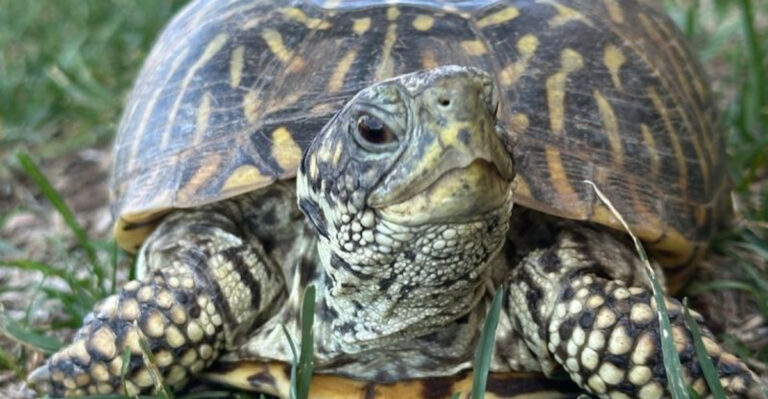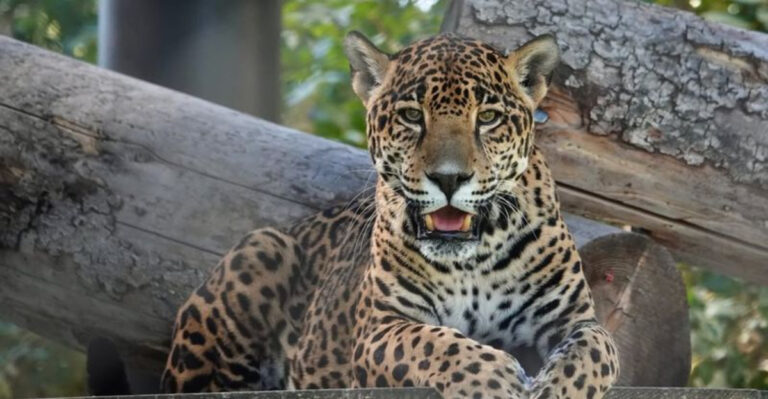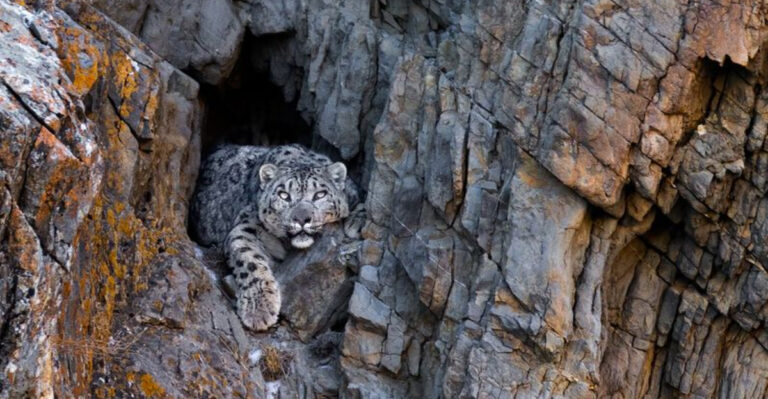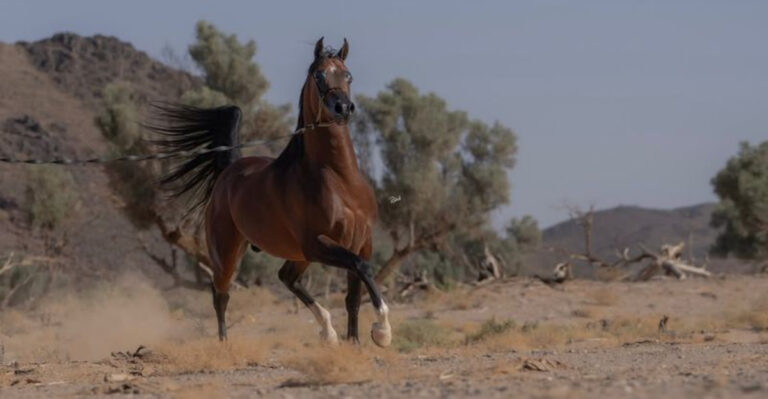These Are The Biggest Reptiles Ever Spotted In Each State
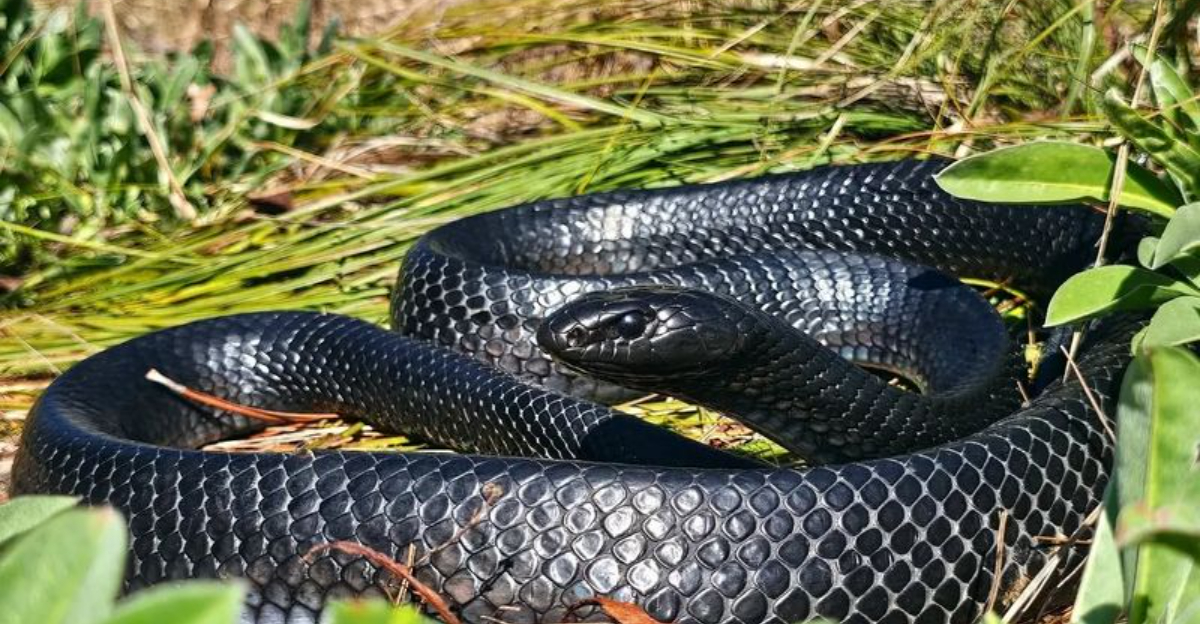
The United States is home to an incredible variety of reptiles, each state boasting its own giant. From the massive American alligators prowling the swamps of Florida to the elusive Gila monsters of Arizona’s deserts, these creatures captivate with their size and mystery.
This list explores the largest reptile in each state, offering insights into their habitats, behaviors, and the unique roles they play in their ecosystems.
1. American Alligator – Florida
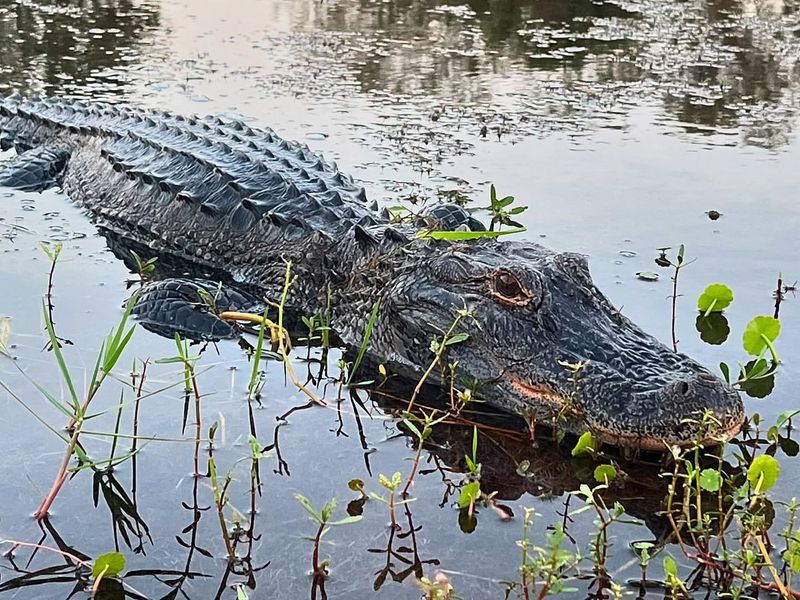
Florida, known for its sunny beaches and vibrant wildlife, is also home to the American alligator, one of the largest reptiles in the United States. Typically found in freshwater environments like swamps and marshes, these creatures can grow up to 13 feet long and weigh over 1,000 pounds.
Their powerful tails and strong jaws make them formidable hunters, able to ambush prey with incredible speed and precision. Beyond their size, American alligators play a crucial role in maintaining the health of their ecosystems.
By creating “alligator holes” with their bodies, they provide habitat for fish and other aquatic life, particularly during dry spells. These reptiles are also indicators of environmental health, as they are sensitive to changes in their surroundings.
While they may seem fearsome, alligator attacks on humans are rare, and they are often more afraid of us than we are of them. With conservation efforts, their populations have rebounded, allowing them to continue their role as keystone species in Florida’s diverse habitats.
2. Gila Monster – Arizona
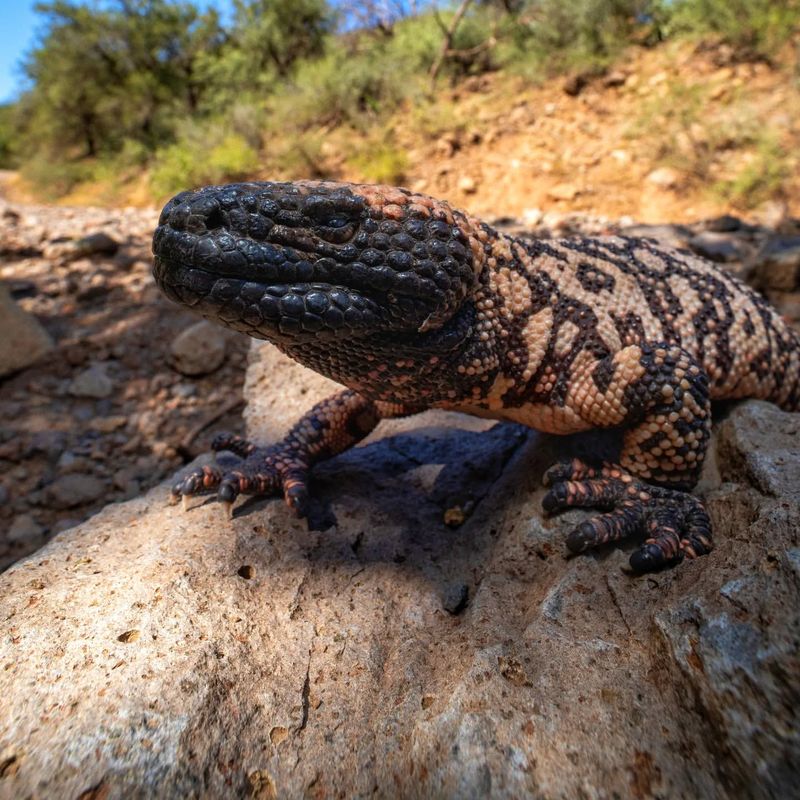
In the arid deserts of Arizona, the Gila monster stands out as one of the largest lizards in the United States. These slow-moving reptiles grow up to 2 feet long and are renowned for their striking orange and black patterns.
Despite their sluggish appearance, Gila monsters possess a venomous bite, which they use defensively rather than for predation. Their diet primarily consists of bird eggs, small mammals, and carrion, which they detect with a keen sense of smell.
Adapted to the harsh desert climate, Gila monsters can survive long periods without food or water, making them true desert survivors. While sightings are rare due to their secretive nature, encountering a Gila monster is a unique experience.
They play a significant role in controlling pest populations, and their venom has even contributed to medical research, leading to discoveries in diabetes treatment. Protecting these fascinating creatures ensures the stability of the ecosystems they inhabit.
3. Eastern Diamondback Rattlesnake – Georgia
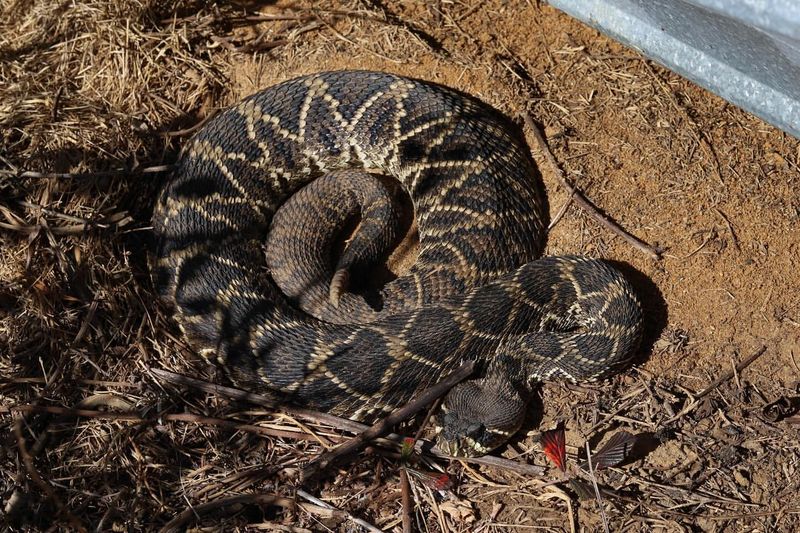
Georgia’s warm climate and diverse ecosystems provide the perfect habitat for the Eastern Diamondback Rattlesnake, the largest venomous snake in North America. Reaching lengths of up to 7 feet, these snakes are known for their distinctive diamond-shaped patterns and intimidating rattle.
They inhabit pine forests, coastal dunes, and hardwood swamps, where they play a crucial role in controlling rodent populations. Despite their fearsome reputation, Eastern Diamondbacks are shy creatures that prefer to avoid humans and will only defend themselves if threatened.
Encountering one in the wild can be startling, but understanding their behavior helps ensure safety for both humans and snakes. Conservation efforts focus on protecting their habitats, as these snakes are vital for maintaining the balance of their ecosystems. Each sighting is a reminder of the rich biodiversity that thrives in Georgia.
4. Green Sea Turtle – Hawaii
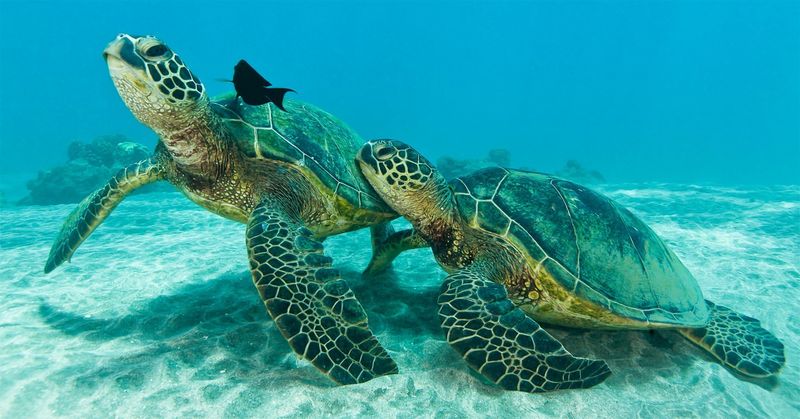
The Hawaiian Islands are not just a paradise for humans but also a vital habitat for the green sea turtle, one of the largest marine reptiles in the world. These gentle giants can weigh over 500 pounds and have a distinct heart-shaped shell that helps them glide effortlessly through the ocean.
Green sea turtles are herbivorous, primarily feeding on seagrasses and algae, which helps maintain healthy coral reef ecosystems. They are often seen basking on sandy beaches, a behavior unique to Hawaiian turtles, which allows them to regulate their body temperature and rest.
These turtles are a symbol of good luck and longevity in Hawaiian culture, and efforts to protect them are essential due to threats like habitat destruction and climate change. Witnessing a green sea turtle in its natural habitat is a magical experience, offering a glimpse into the vibrant marine life that flourishes around the islands.
5. American Crocodile – Florida
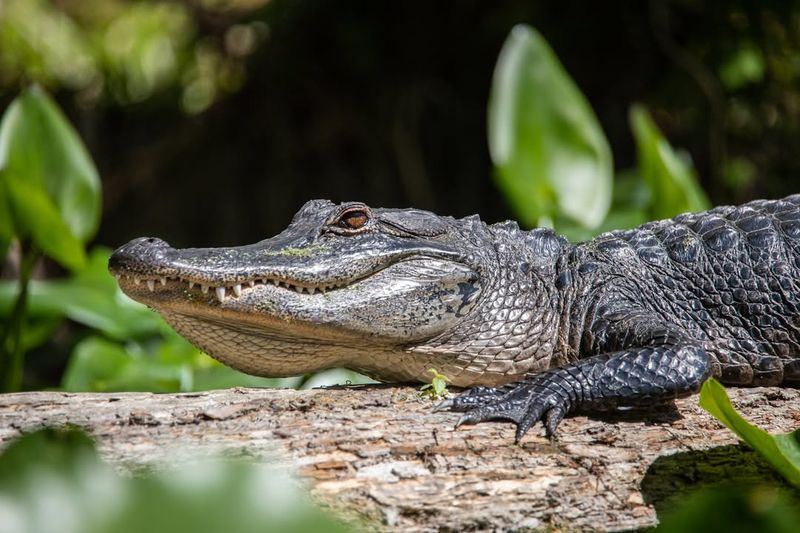
Florida is unique in that it hosts two of the largest reptiles in the US, including the lesser-known American crocodile. Found primarily in the southern tip of the state, these crocodiles prefer brackish and saltwater habitats, unlike their alligator cousins.
Growing up to 15 feet in length, American crocodiles have a more slender snout and lighter coloration compared to alligators. They are shy and reclusive creatures, often avoiding human interaction, which makes sightings relatively rare.
Conservation efforts in Florida have helped stabilize their populations, and they are now considered a conservation success story. These apex predators are crucial for the health of their ecosystems, helping to maintain the populations of fish and other aquatic species.
6. Common Snapping Turtle – New York
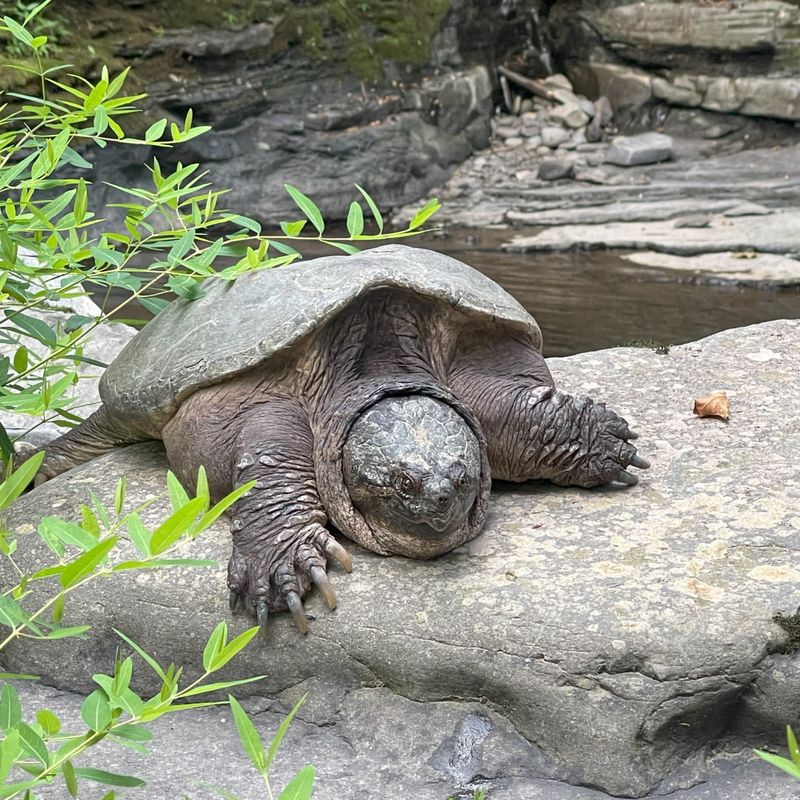
In the waterways of New York, the common snapping turtle reigns as one of the largest freshwater turtles in North America. Known for their powerful jaws and spiny shells, these turtles can weigh up to 35 pounds and have a distinct, rugged appearance.
Snapping turtles are omnivorous, feeding on plants, insects, fish, and even small mammals, playing an essential role in keeping aquatic ecosystems balanced. They have a unique hunting technique, remaining motionless and camouflaged until prey comes close, then snapping with lightning speed.
Despite their intimidating look, snapping turtles are generally docile unless provoked. They contribute to the natural cleanup of waterways by scavenging dead animals, and protecting their habitats ensures these ancient reptiles continue to thrive in New York’s diverse environments.
7. Timber Rattlesnake – Pennsylvania
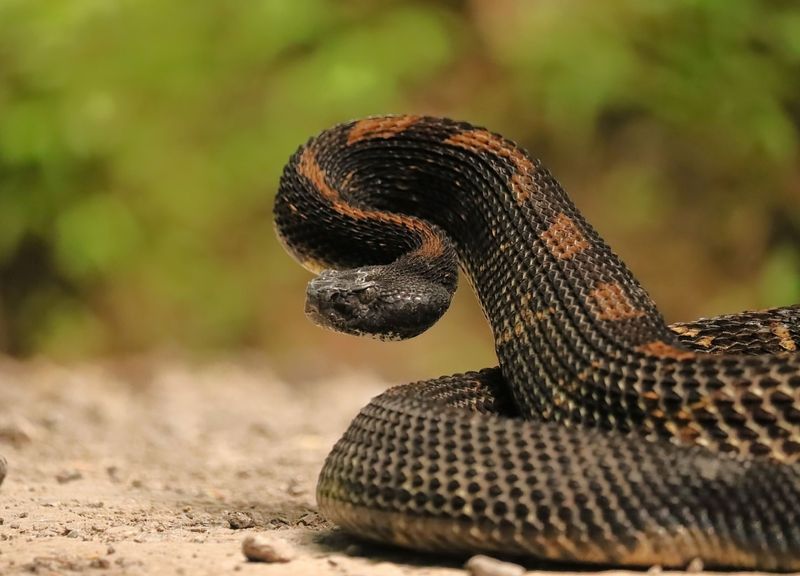
The timber rattlesnake calls Pennsylvania’s mountainous regions home, where it blends into the rocky terrain with its muted colors and distinctive rattle. This venomous snake can grow up to 5 feet long, preferring deciduous forests where it can hunt small mammals.
Timber rattlesnakes are an integral part of the ecosystem, controlling rodent populations and serving as prey for larger predators. Their venom is highly adapted for hunting, and while potentially dangerous to humans, they are non-aggressive and usually flee when encountered.
Recognizing their presence in the wild is essential for coexistence, as education and conservation efforts help protect both people and these important reptiles. Their presence is a testament to the ecological richness of Pennsylvania’s wilderness.
8. Eastern Hellbender – North Carolina
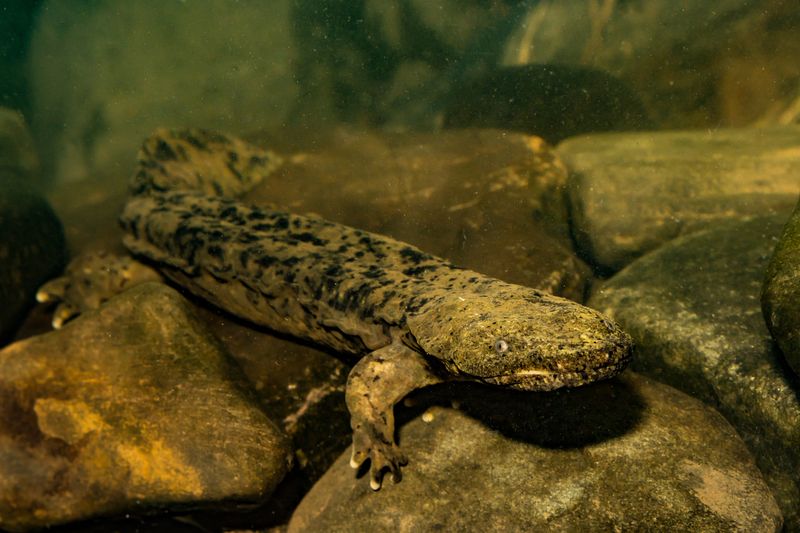
Though not a traditional reptile, the Eastern Hellbender is a significant amphibian found in the streams of North Carolina. Often mistaken for a reptile due to its size, this giant salamander can grow up to 2 feet long, making it the largest in North America.
Hellbenders thrive in fast-flowing, clean water, where they hunt crayfish and small fish. Their unique, flattened bodies and loose skin help them maneuver in rocky streambeds, and they breathe through their skin, requiring pristine water quality.
These fascinating creatures are indicators of healthy aquatic ecosystems, and their decline signals environmental challenges. Conservation initiatives focus on habitat protection and pollution reduction, ensuring these “water dogs” continue to inhabit North Carolina’s waterways.
9. Blanding’s Turtle – Nebraska
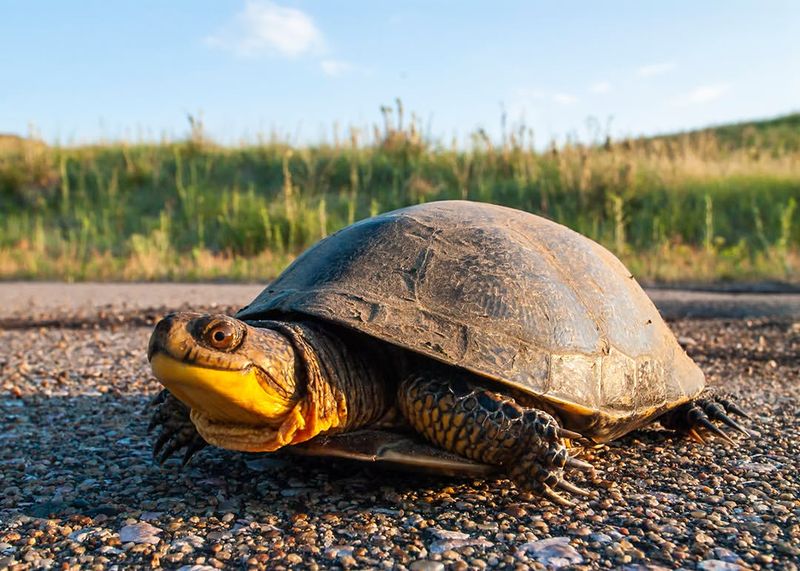
The Blanding’s turtle, with its distinctive yellow throat and smile-like face, is a unique inhabitant of Nebraska’s wetlands. Growing up to 10 inches long, these turtles are semi-aquatic, dividing their time between water and land.
They prefer shallow wetlands and marshes, where they feed on crustaceans, insects, and plants. Blanding’s turtles are known for their longevity, with some living over 70 years, and they have a delayed maturity, not breeding until they are around 20 years old.
Their populations are declining due to habitat loss and fragmentation, making conservation efforts vital. Protecting their habitats ensures these charming turtles continue to grace Nebraska’s landscapes, contributing to the biodiversity of the region.
10. Desert Tortoise – Nevada
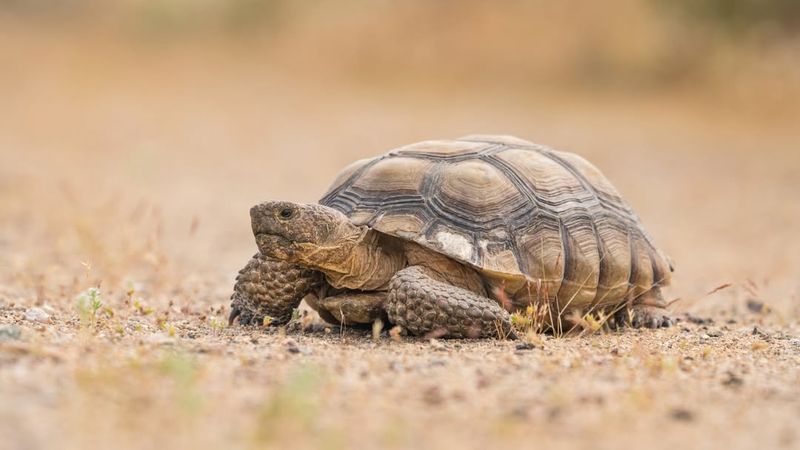
The desert tortoise is an iconic resident of Nevada’s arid landscapes, embodying resilience and adaptation. These reptiles can weigh up to 15 pounds, with domed shells that help them retain moisture in the harsh desert environment.
Desert tortoises are herbivorous, grazing on grasses and flowers, and they spend much of their time in burrows to escape the extreme temperatures. Their ability to survive without water for long periods is testament to their remarkable adaptation skills.
As a threatened species, the desert tortoise’s survival depends on habitat protection and careful management. Efforts to mitigate human impact and preserve their natural habitats are essential to ensuring that these unique tortoises continue to thrive in Nevada’s deserts.
11. Alligator Snapping Turtle – Louisiana
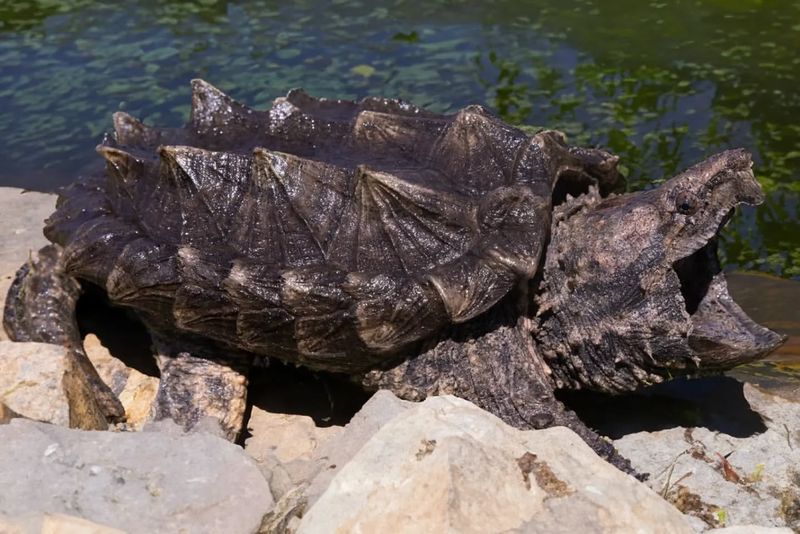
Louisiana’s bayous are home to the alligator snapping turtle, one of the largest freshwater turtles in the world. Known for its prehistoric appearance, this turtle can weigh over 200 pounds and is distinctive for its rugged shell and powerful bite.
These turtles are primarily carnivorous, using a unique lure technique to attract fish by wiggling a worm-like appendage on their tongues. They lie in wait, snapping their jaws shut with incredible force when prey ventures too close.
Conservation efforts are crucial for this vulnerable species, as habitat destruction and overharvesting have led to population declines. Protecting the bayous and educating the public about these fascinating creatures help ensure their continued existence in Louisiana’s diverse ecosystems.
12. Common Iguana – Puerto Rico
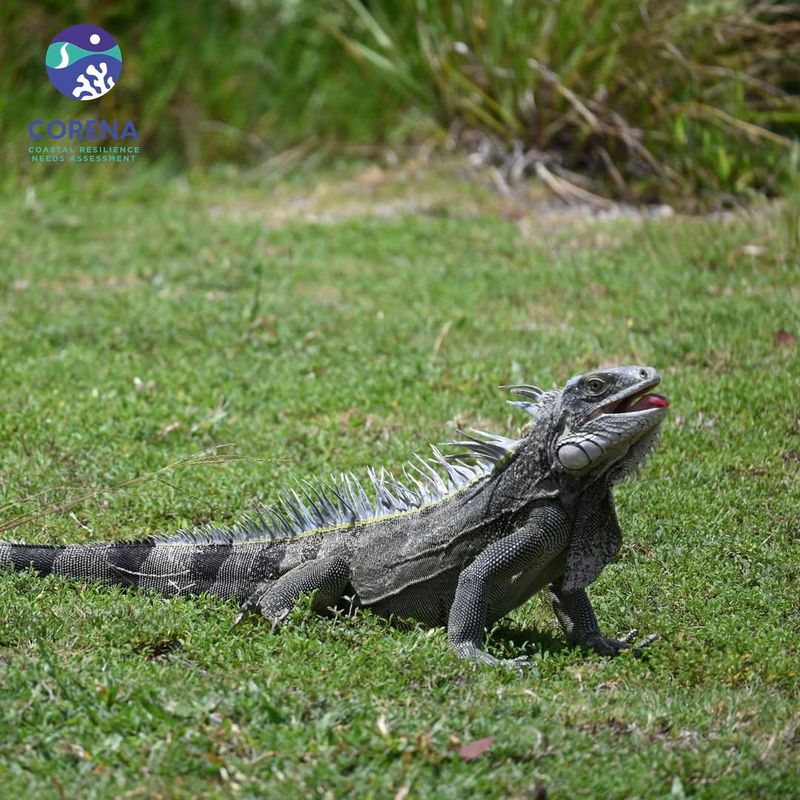
In the lush landscapes of Puerto Rico, the common iguana, also known as the green iguana, is a prominent and often seen reptile. These sizable lizards can grow up to 6 feet in length, with their long tails accounting for much of their size.
Iguanas are herbivorous, feeding on leaves, flowers, and fruits, and they play a role in seed dispersal throughout their habitats. They are often found basking in the sun on tree branches, their vibrant green coloring providing excellent camouflage among the leaves.
Though not native to Puerto Rico, iguanas have become a part of the island’s ecosystem. Managing their populations is essential, as they can impact local flora and fauna. Understanding their habits and ecological roles helps balance conservation efforts with the needs of the environment.
13. Leatherback Sea Turtle – California
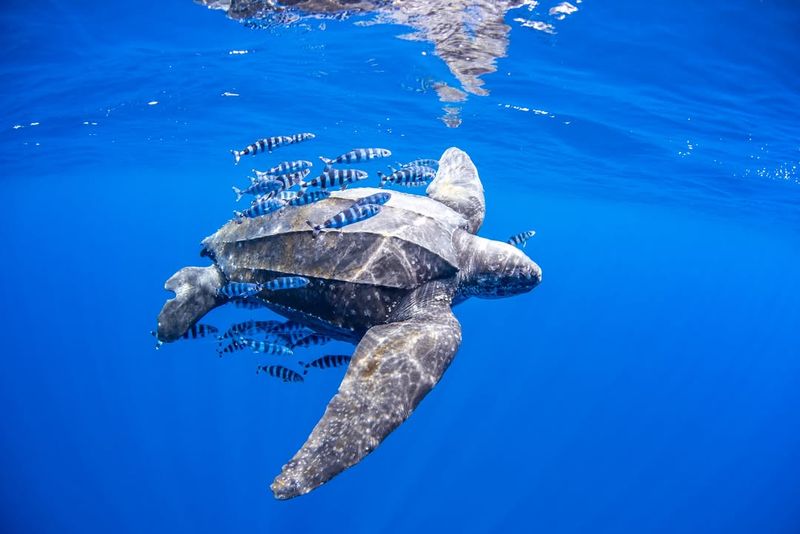
California’s coastal waters provide critical nesting grounds for the leatherback sea turtle, the largest of all sea turtles. These majestic reptiles can weigh over 1,500 pounds, with shells that are unique for their leathery texture and ridged appearance.
Leatherbacks are known for their extensive migrations, traveling thousands of miles across the ocean to feed on jellyfish, their primary diet. Their ability to regulate their body temperature allows them to venture into colder waters, unlike other sea turtles.
Protecting leatherbacks is a priority due to threats from fishing practices, pollution, and climate change. Conservation efforts focus on safeguarding their nesting sites and ensuring safe passage through oceanic habitats. Witnessing a leatherback sea turtle in its natural setting is awe-inspiring, a testament to the ocean’s wonders.
14. Burmese Python – Florida
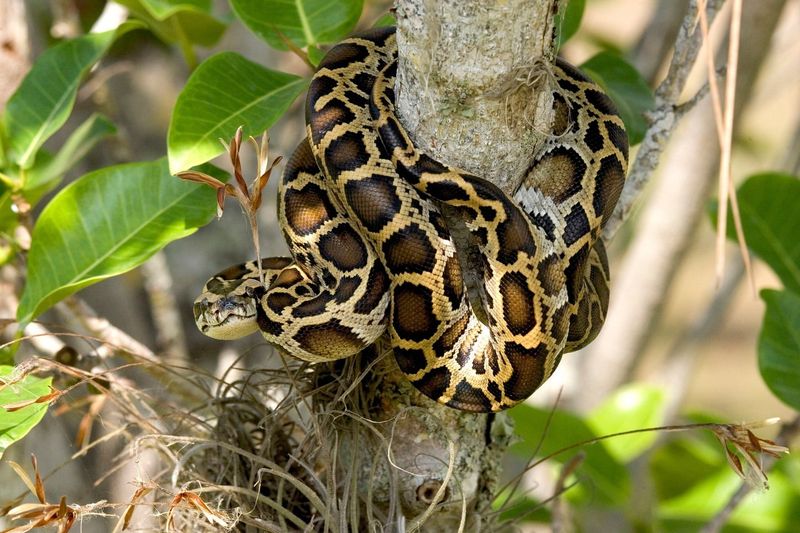
The Burmese python, though not native, is one of the largest reptiles now residing in Florida, particularly within the Everglades. These snakes can grow over 20 feet long and weigh up to 200 pounds, making them formidable predators.
Originally from Southeast Asia, Burmese pythons became established in Florida through the pet trade and subsequent release into the wild. They pose a significant ecological threat, preying on native wildlife and disrupting the balance of the ecosystem.
Efforts to control their population include organized hunts and public awareness campaigns. While their presence challenges native species, understanding their impact and working towards solutions is crucial for the health of Florida’s natural habitats.
15. Sonoran Desert Toad – Arizona
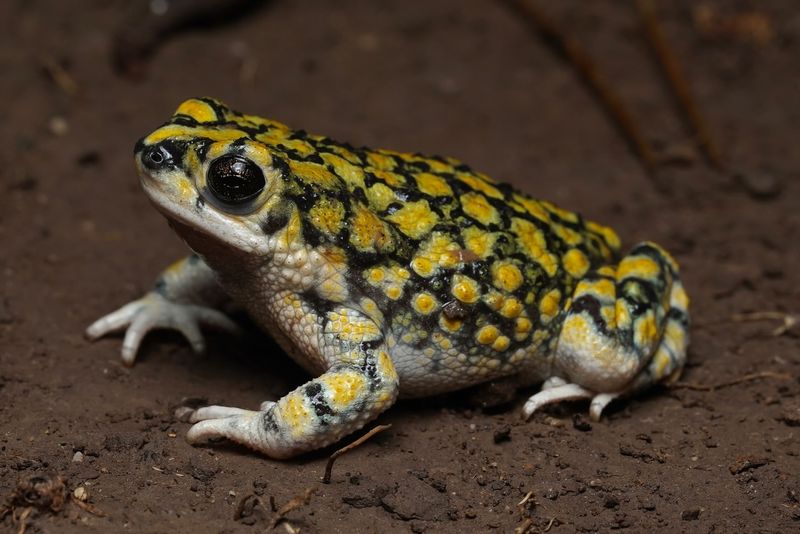
Arizona’s Sonoran Desert is home to the Sonoran Desert toad, one of the largest toads in North America. These amphibians can grow up to 7 inches long and are known for their smooth, olive-green skin and large parotoid glands.
Sonoran Desert toads are nocturnal, emerging during the monsoon season when the desert becomes alive with activity. Their loud, distinctive calls can be heard echoing through the night as they seek mates. These toads are renowned for their potent toxins, which serve as a defense against predators.
While fascinating, they require careful handling, as their secretions can be harmful to humans and pets. Conservation and education efforts ensure the continued survival of these unique creatures in Arizona’s dynamic desert ecosystem.
16. Cottonmouth Snake – Mississippi
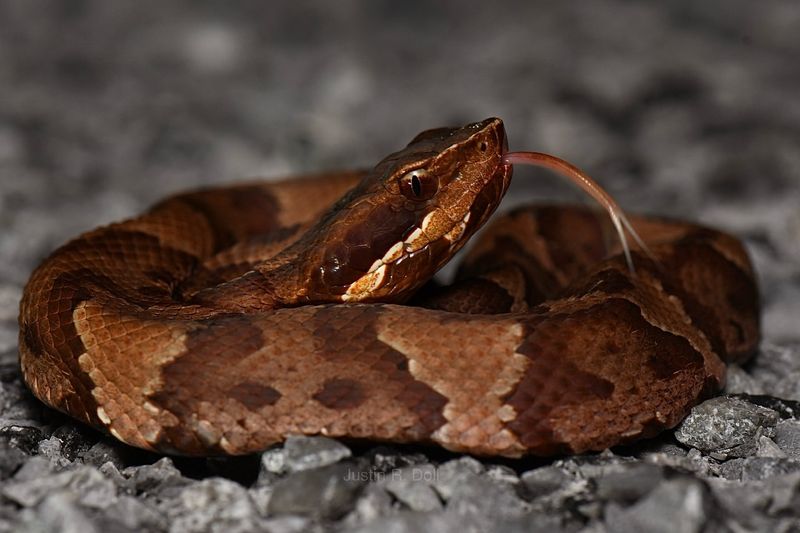
Mississippi’s wetlands are the domain of the cottonmouth snake, also known as the water moccasin. This venomous snake can grow up to 4 feet long and is easily recognizable by the white lining of its mouth, displayed when threatened.
Cottonmouths are semi-aquatic, thriving in swamps, marshes, and slow-moving rivers. They are opportunistic feeders, preying on fish, amphibians, and small mammals, and play a vital role in controlling pest populations.
Despite their reputation, cottonmouths are not aggressive and prefer to avoid confrontation. Understanding their behavior and respecting their habitat are key to coexisting safely with these remarkable reptiles. Protecting Mississippi’s wetlands also ensures the preservation of the cottonmouth’s essential role in the ecosystem.
17. Western Diamondback Rattlesnake – Texas
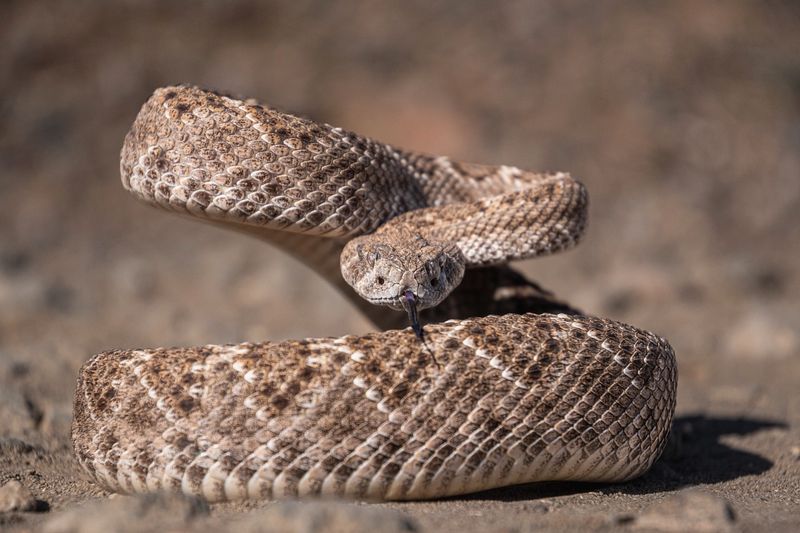
Texas, with its diverse terrains, is home to the Western Diamondback Rattlesnake, a prominent and intimidating reptile. These snakes can reach lengths of up to 7 feet and are characterized by their distinctive diamond patterns and loud rattles.
Western Diamondbacks inhabit deserts, grasslands, and rocky hills, where they control rodent populations and serve as prey for larger animals. They are skilled ambush predators, relying on their camouflage and quick strikes to capture prey.
Though feared, these snakes are vital to the ecosystem, and their presence indicates a healthy environment. Education and awareness help reduce unnecessary killings and promote coexistence between humans and these essential reptiles. Encountering a Western Diamondback in the wild is a reminder of the intricate balance maintained in Texas’ natural landscapes.
18. Red-Eared Slider – Illinois
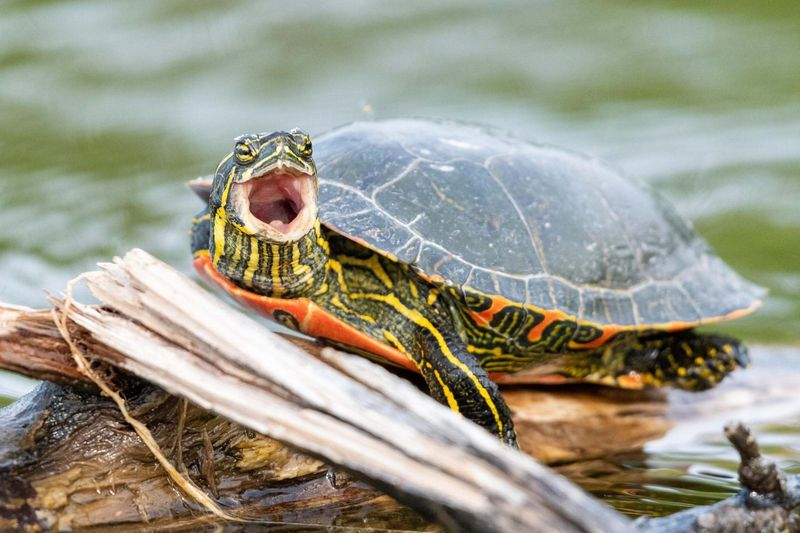
Illinois’ ponds and slow-moving rivers are home to the red-eared slider, a popular turtle both in the wild and as a pet. These turtles can grow up to 12 inches long, with striking red markings on the sides of their heads.
Red-eared sliders are omnivorous, consuming aquatic vegetation, insects, and fish, contributing to the health of their aquatic environments. They are known for their basking behavior, often seen sunning themselves on rocks and logs.
Though charming, red-eared sliders can be invasive, outcompeting native species for resources. Responsible pet ownership and habitat management are crucial to ensuring these turtles do not disrupt local ecosystems. Enjoying their presence in the wild provides insight into the dynamic life of Illinois’ waterways.
19. Prairie Rattlesnake – South Dakota
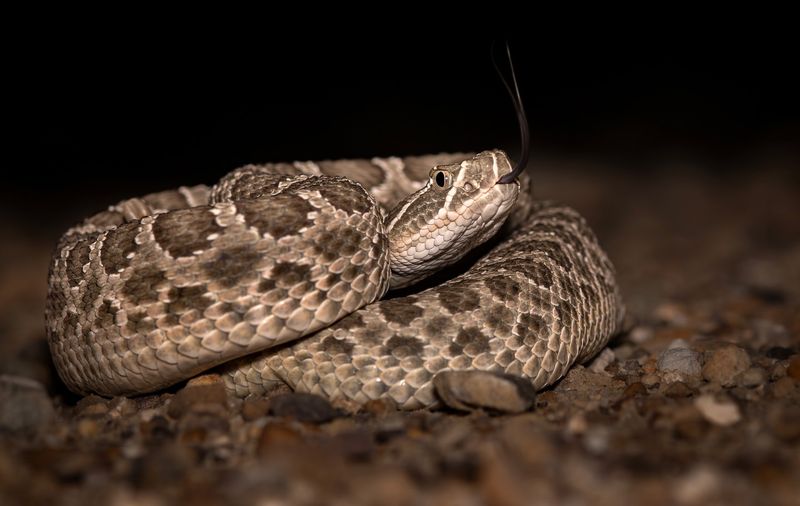
South Dakota’s vast plains are home to the prairie rattlesnake, a resilient and adaptable predator. These snakes can reach up to 4 feet in length and are known for their muted brown and green scales, which provide excellent camouflage.
Prairie rattlesnakes play a crucial role in maintaining the ecological balance by preying on rodents and small mammals. Their presence helps control pest populations, benefiting both natural habitats and agricultural areas.
While encounters with humans are rare, understanding and respecting their role in the ecosystem is essential for coexistence. Conservation efforts focus on habitat preservation, ensuring that prairie rattlesnakes continue to thrive in South Dakota’s open landscapes.
20. Copperhead Snake – Virginia
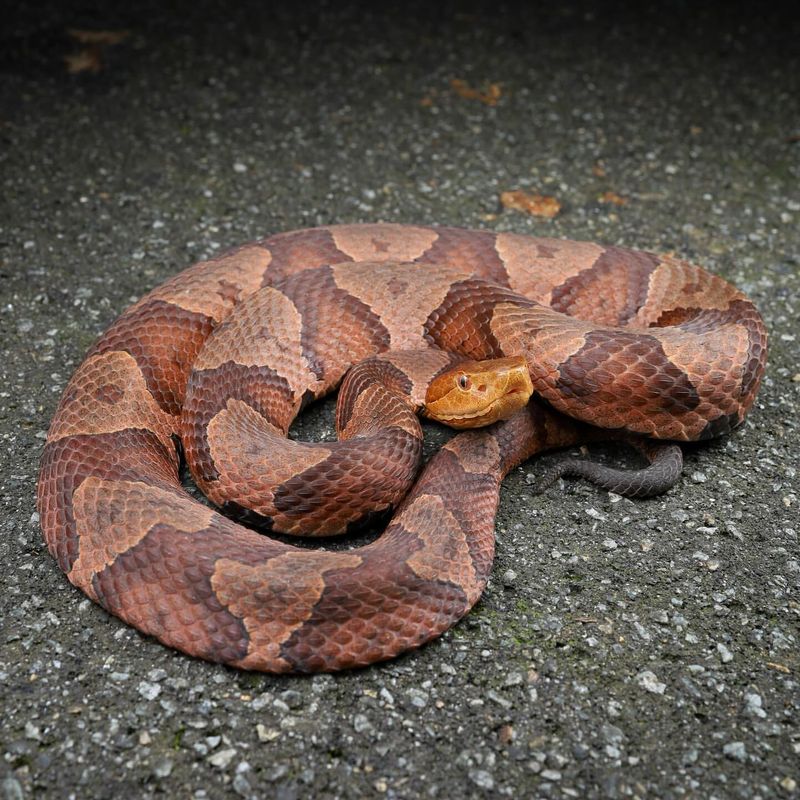
Virginia’s deciduous forests are home to the copperhead snake, a venomous species known for its distinctive copper-colored scales. Though smaller than some other venomous snakes, copperheads can reach up to 3 feet in length and are recognized by their hourglass-shaped markings.
These snakes are primarily nocturnal, hunting small rodents and insects, and play a vital role in controlling pest populations. Despite their venom, copperheads are not aggressive and will often freeze to avoid detection by predators and humans alike.
Understanding their behavior and habitat preferences helps mitigate potential conflicts, promoting safe coexistence. Conservation of forested areas ensures these important reptiles continue to contribute to Virginia’s rich biodiversity.
21. Yellow-Bellied Slider – South Carolina
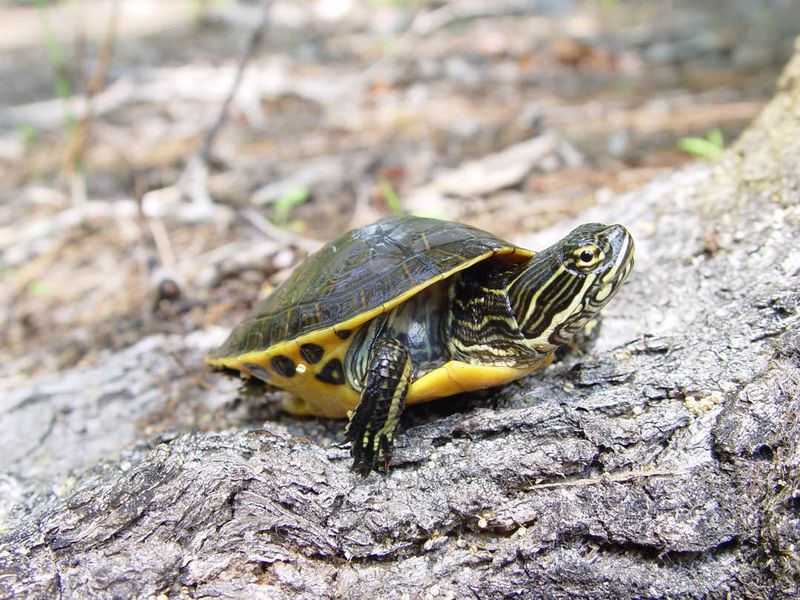
South Carolina’s freshwater habitats are graced by the yellow-bellied slider, a turtle renowned for its striking yellow plastron and lively demeanor. These turtles can grow up to 10 inches long and are commonly observed basking in the sun.
Yellow-bellied sliders are omnivorous, feeding on aquatic plants, insects, and small fish, contributing to the balance of their ecosystems. Their adaptability allows them to thrive in a variety of aquatic environments, from ponds to slow-moving rivers.
These turtles are popular in the pet trade, which necessitates responsible ownership to prevent ecological disruption. Protecting their natural habitats ensures that yellow-bellied sliders continue to enrich the waters of South Carolina, offering glimpses of their vibrant aquatic world.
22. Eastern Box Turtle – Maryland
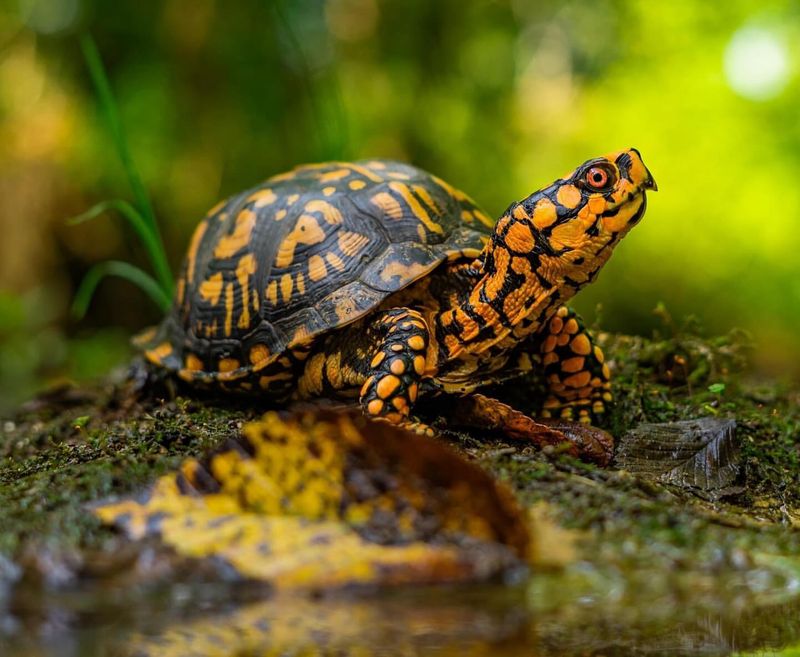
Maryland’s forests and meadows are home to the Eastern box turtle, a terrestrial turtle known for its colorful shell and gentle nature. These turtles can live up to 100 years and grow to about 6 inches in length.
Box turtles are omnivorous, feeding on a variety of insects, plants, and fruits, playing a role in seed dispersal and pest control. Their hinged plastrons allow them to retreat fully into their shells, offering protection from predators.
Despite their adaptive abilities, habitat loss and road mortality threaten their populations. Conservation efforts focus on habitat protection and raising public awareness about their ecological importance. Encountering an Eastern box turtle is a delightful experience, showcasing Maryland’s diverse wildlife.
23. Diamondback Terrapin – Delaware
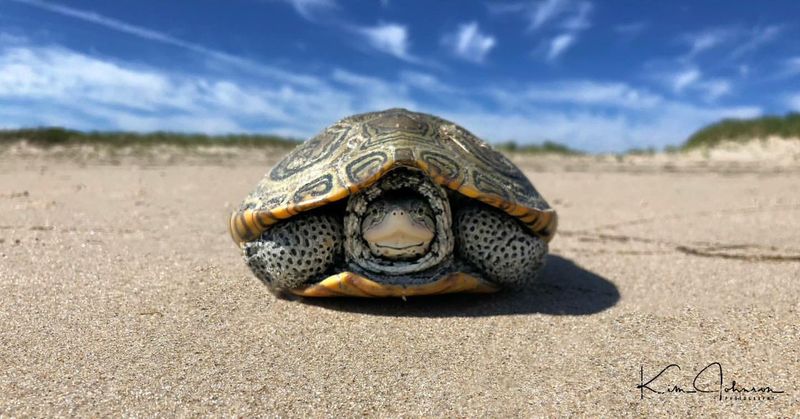
Delaware’s coastal marshes and estuaries provide a haven for the diamondback terrapin, a turtle distinguished by its unique shell patterns and brackish water habitat. These turtles grow up to 9 inches long and are known for their striking diamond-shaped markings.
Diamondback terrapins are carnivorous, feeding on mollusks, crustaceans, and fish, contributing to the ecological balance of their environments. Their ability to tolerate varying salinity levels makes them adaptable to different coastal habitats.
Conservation challenges include habitat destruction and bycatch in fishing gear, prompting efforts to protect their habitats and ensure sustainable populations. Observing a diamondback terrapin in its natural setting offers a glimpse into the intricate ecosystems of Delaware’s coastlines.
24. Gopher Tortoise – Alabama
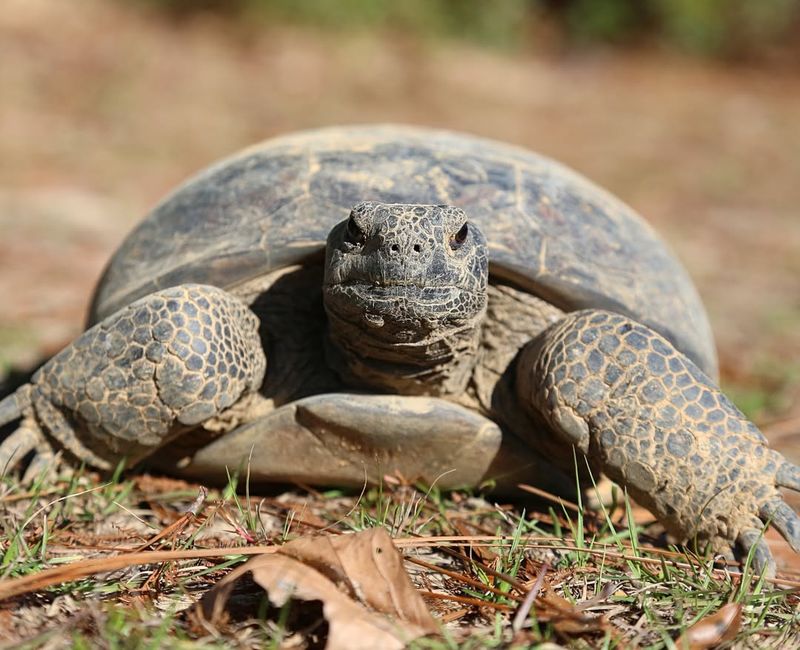
Alabama’s sandy soils and open woodlands are the perfect environment for the gopher tortoise, a keystone species known for its burrowing habits. These tortoises can weigh up to 15 pounds and have strong legs adapted for digging extensive burrows.
Gopher tortoises are herbivorous, feeding on a variety of grasses and plants, and their burrows provide shelter for numerous other species, including insects, small mammals, and even other reptiles. This mutualistic relationship highlights their critical role in their ecosystems.
Conservation of gopher tortoises focuses on habitat protection and mitigating threats from human activities. Protecting these ancient reptiles ensures the continued health and diversity of Alabama’s landscapes, where they contribute to the ecological fabric.
25. Bullsnake – Iowa
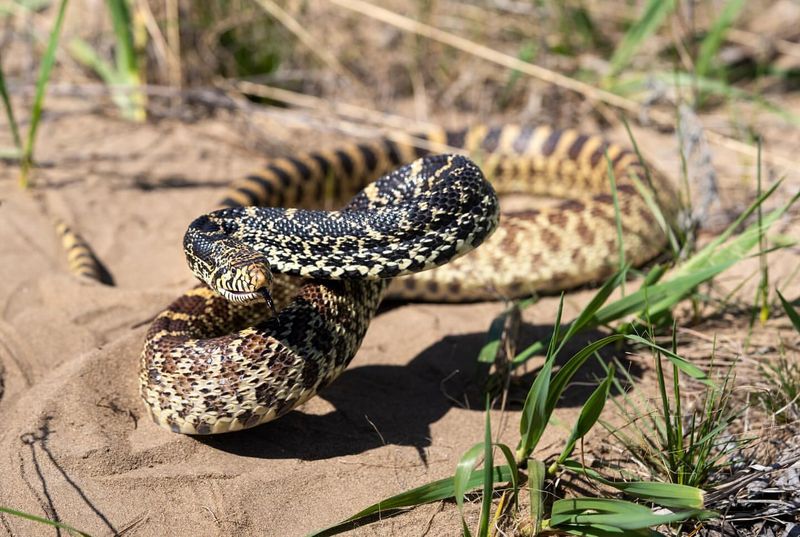
Iowa’s prairies and farmlands are inhabited by the bullsnake, one of the largest snake species in the state. Known for their size, they can grow up to 8 feet long and are easily recognized by their yellow and brown patterns.
Bullsnakes are non-venomous and primarily feed on rodents, making them beneficial for controlling pest populations in agricultural areas. Their defensive behaviors, such as hissing and mimicking rattlesnakes, often lead to mistaken identities.
Educating the public about the bullsnake’s role in the ecosystem helps reduce unnecessary fear and encourages conservation efforts. By protecting their habitats, these impressive snakes continue to thrive in Iowa’s natural landscapes, contributing to ecological balance.
26. Great Basin Gopher Snake – Utah
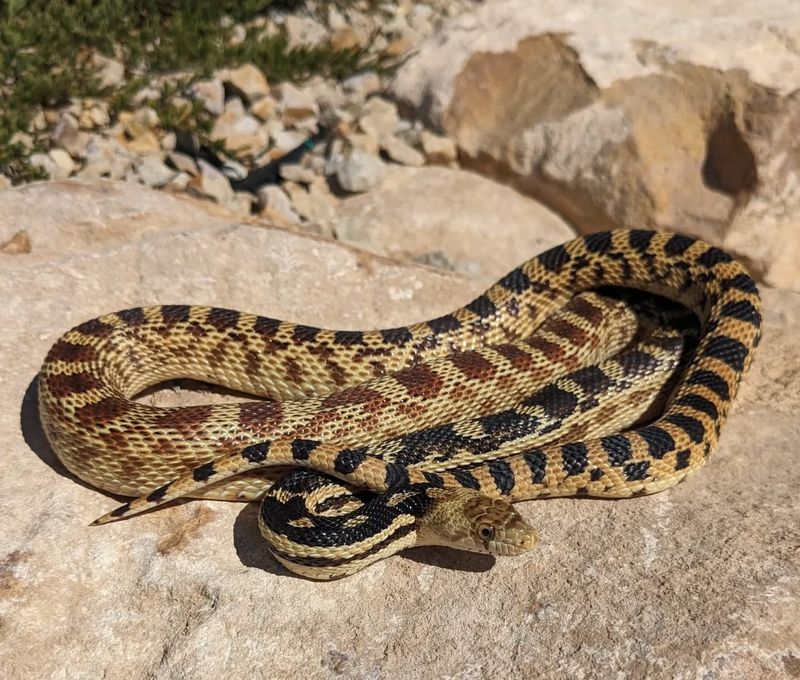
Utah’s diverse landscapes are home to the Great Basin gopher snake, a large and adaptable species. These snakes can grow up to 7 feet long and are known for their light and dark patterned scales, mimicking more dangerous species.
Gopher snakes are non-venomous and primarily prey on rodents, playing a crucial role in controlling pest populations. Their presence is a sign of a healthy ecosystem, as they occupy various habitats, from deserts to grasslands.
While often mistaken for rattlesnakes, gopher snakes are harmless and benefit from public education about their ecological importance. Conservation efforts include habitat protection, ensuring these snakes continue to thrive in Utah’s dynamic environments, where they contribute to the balance of nature.
27. Box Turtle – Indiana
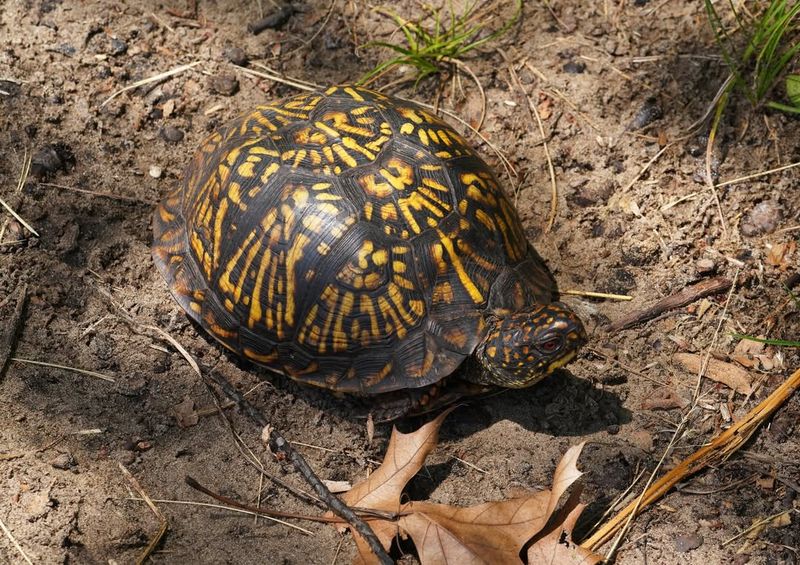
Indiana’s woodlands and grasslands provide a home for the box turtle, a terrestrial reptile known for its ornate shell and long lifespan. These turtles can live for several decades, reaching lengths of up to 6 inches.
Box turtles are omnivorous, consuming insects, plants, and fruits, playing a role in seed dispersal and pest control. Their ability to fully retreat into their shells offers protection from predators, and they are often seen slowly making their way through underbrush.
Habitat loss and road mortality are significant threats to box turtles, necessitating conservation efforts focused on habitat preservation and public education. Encountering a box turtle in the wild is a reminder of the rich biodiversity that thrives in Indiana’s natural environments.
28. Eastern Indigo Snake – Georgia
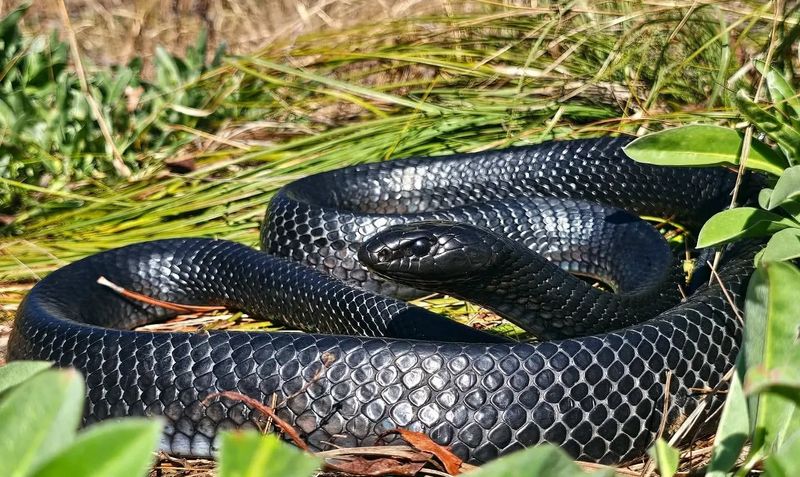
Georgia’s diverse ecosystems are home to the Eastern indigo snake, the longest native snake in the United States. These impressive reptiles can reach lengths of up to 8 feet and are known for their glossy, iridescent black scales.
Eastern indigo snakes are non-venomous and play a crucial role in controlling populations of other snakes, including venomous species. Their presence indicates healthy ecosystems, and they inhabit forests, wetlands, and coastal dunes.
Conservation efforts focus on habitat preservation and protection from human threats, as these snakes are endangered due to habitat loss. Ensuring the survival of the Eastern indigo snake contributes to maintaining ecological balance in Georgia’s natural landscapes.
29. Cottonmouth – Arkansas
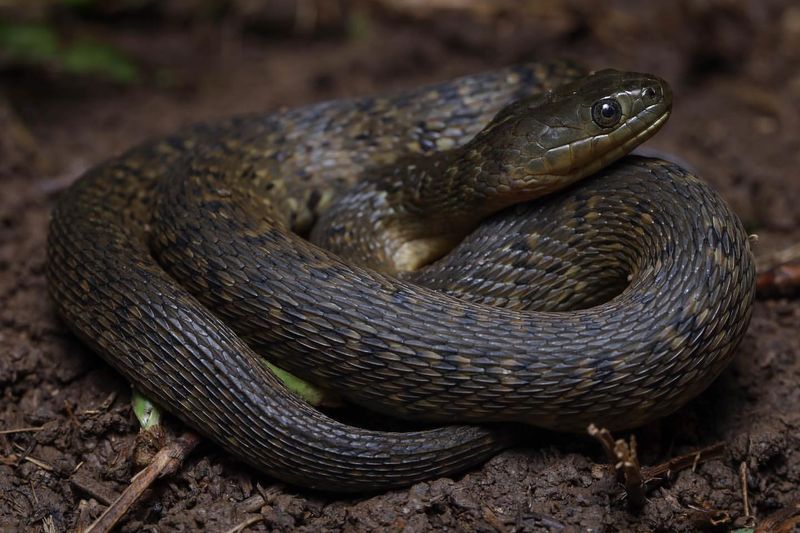
Arkansas’ wetlands and waterways host the cottonmouth snake, a semi-aquatic species known for its distinctive white mouth lining. These venomous snakes can grow up to 4 feet in length and are often found in swamps, marshes, and slow-moving rivers.
Cottonmouths are opportunistic feeders, preying on fish, amphibians, and small mammals, and play a vital role in controlling pest populations. Despite their reputation, they are not aggressive and prefer to avoid human encounters.
Understanding cottonmouth behavior and respecting their habitat are key to coexistence, promoting conservation efforts that protect both the snakes and their ecosystems. Observing a cottonmouth in the wild highlights the intricate biodiversity of Arkansas’ aquatic environments.
30. Spiny Softshell Turtle – Kansas
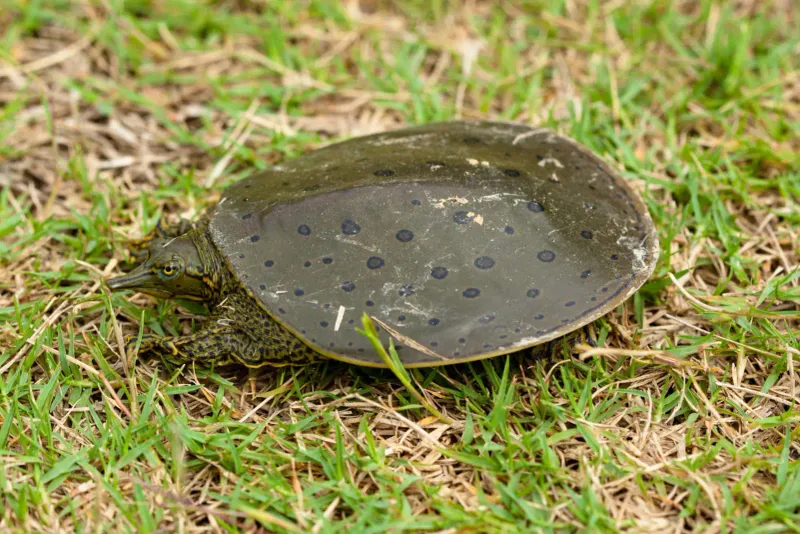
Kansas’ rivers and lakes are inhabited by the spiny softshell turtle, a species notable for its unique, leathery shell and snorkel-like nose. These turtles can grow up to 18 inches in length, with long necks and agile swimming abilities.
Spiny softshell turtles are carnivorous, feeding on insects, fish, and crustaceans, contributing to the ecological balance of their aquatic environments. Their flattened shells and webbed feet make them excellent swimmers, able to move swiftly through water.
Despite their adaptability, habitat destruction and pollution pose threats to their populations. Conservation efforts focus on protecting their habitats and raising awareness about their ecological roles.
Observing a spiny softshell turtle in its natural environment offers a glimpse into the dynamic ecosystems of Kansas’ waterways.
31. Eastern Coral Snake – North Carolina
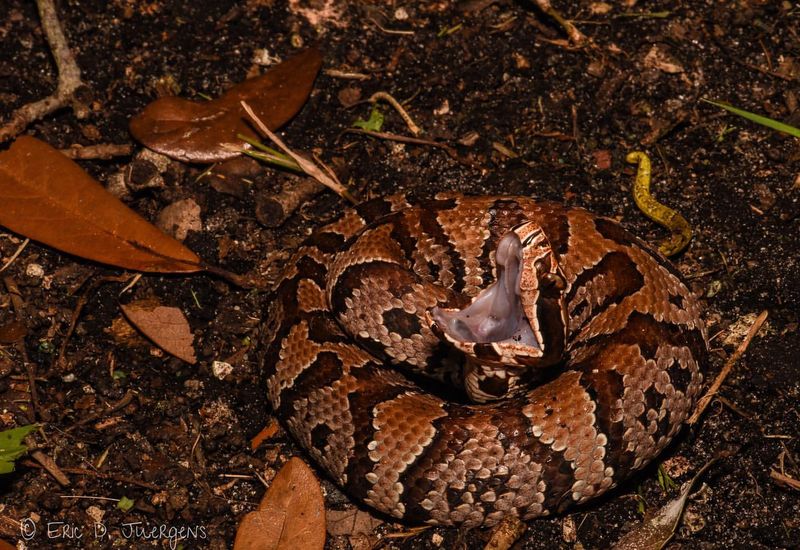
North Carolina’s forests and woodlands are home to the Eastern coral snake, a small but highly venomous species known for its striking red, yellow, and black bands. These snakes rarely grow longer than 30 inches and are elusive, often hiding beneath logs and leaf litter.
Coral snakes are shy and secretive, primarily feeding on other snakes and small reptiles. Their potent venom is used defensively, and they pose little threat to humans due to their reclusive nature.
Education and awareness about coral snakes help prevent unnecessary fear and ensure their protection within their natural habitats. Observing an Eastern coral snake is a rare and exciting experience, highlighting the rich biodiversity of North Carolina’s ecosystems.
32. Eastern Indigo Snake – Florida
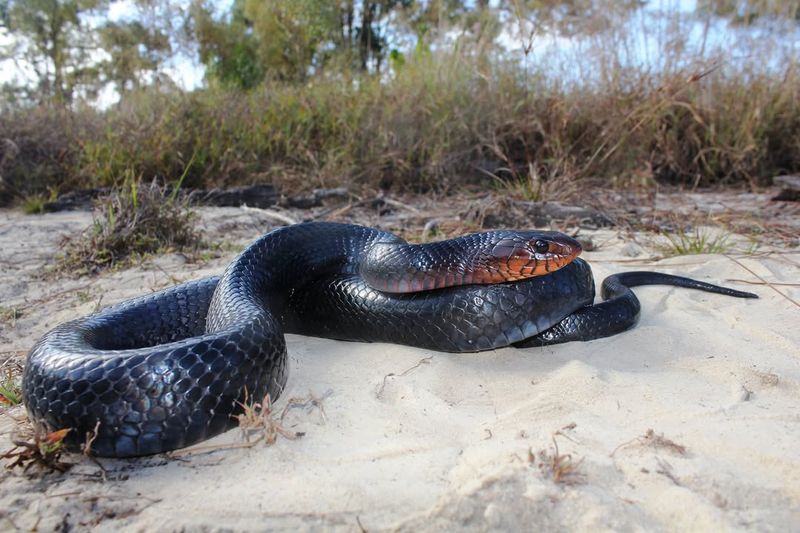
The Eastern indigo snake is a magnificent denizen of Florida’s diverse habitats, known for its impressive size and striking appearance. As the longest native snake in the United States, these reptiles can reach lengths of up to 8 feet, easily recognized by their lustrous black scales.
Indigo snakes are non-venomous and play a crucial role in controlling the populations of other snakes, including venomous species. They inhabit a variety of environments, from forests and wetlands to coastal dunes, contributing to the balance of Florida’s ecosystems.
Conservation efforts are essential for the survival of the Eastern indigo snake, as habitat loss poses significant threats to their populations. Protecting these snakes ensures the continued health and diversity of the environments they call home, where their presence signifies a thriving ecosystem.
33. Wood Turtle – Michigan
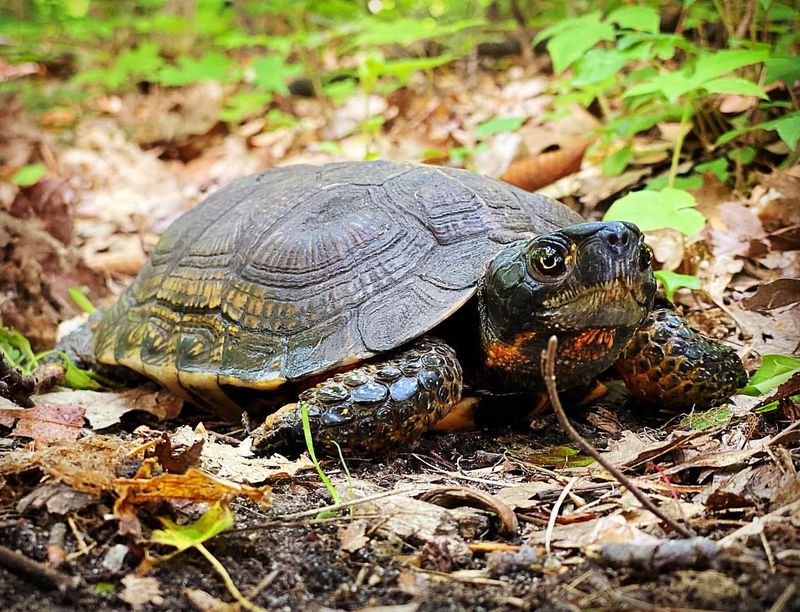
Michigan’s woodlands and rivers host the wood turtle, a semi-aquatic species known for its distinctive shell and vibrant throat coloration. These turtles can grow up to 8 inches long and are often observed basking on logs near water.
Wood turtles are omnivorous, feeding on a variety of plants and small invertebrates, and they play a role in seed dispersal and controlling insect populations. Their rugged shells and bright orange throats are distinctive features that add to the allure of these fascinating reptiles.
Threats from habitat destruction and human interference necessitate conservation efforts focused on habitat preservation and education. Observing a wood turtle in its natural habitat offers a glimpse into the rich biodiversity that thrives in Michigan’s natural landscapes.
34. Blanding’s Turtle – Minnesota
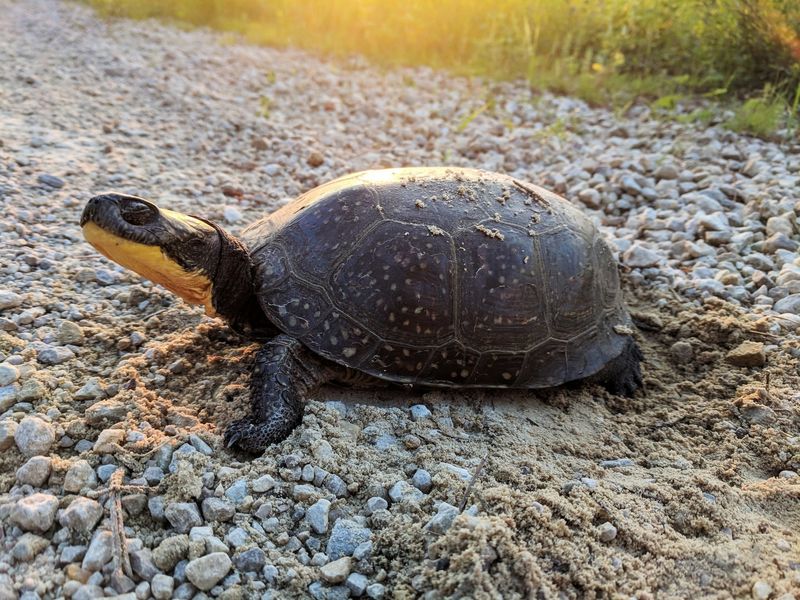
Minnesota’s wetlands and shallow lakes provide the ideal habitat for the Blanding’s turtle, a species known for its distinctive yellow chin and smile-like expression. These turtles can grow up to 10 inches long and are semi-aquatic, favoring environments with abundant vegetation.
Blanding’s turtles are omnivorous, feeding on crustaceans, insects, and aquatic plants, contributing to the balance of their ecosystems. They are long-lived and have a delayed maturity, not breeding until they are around 20 years old.
Conservation efforts focus on habitat protection and mitigating threats such as road mortality and habitat fragmentation. Protecting these charming turtles ensures their continued presence in Minnesota’s diverse environments, where they contribute to maintaining ecological balance.
35. Green Anole – Texas
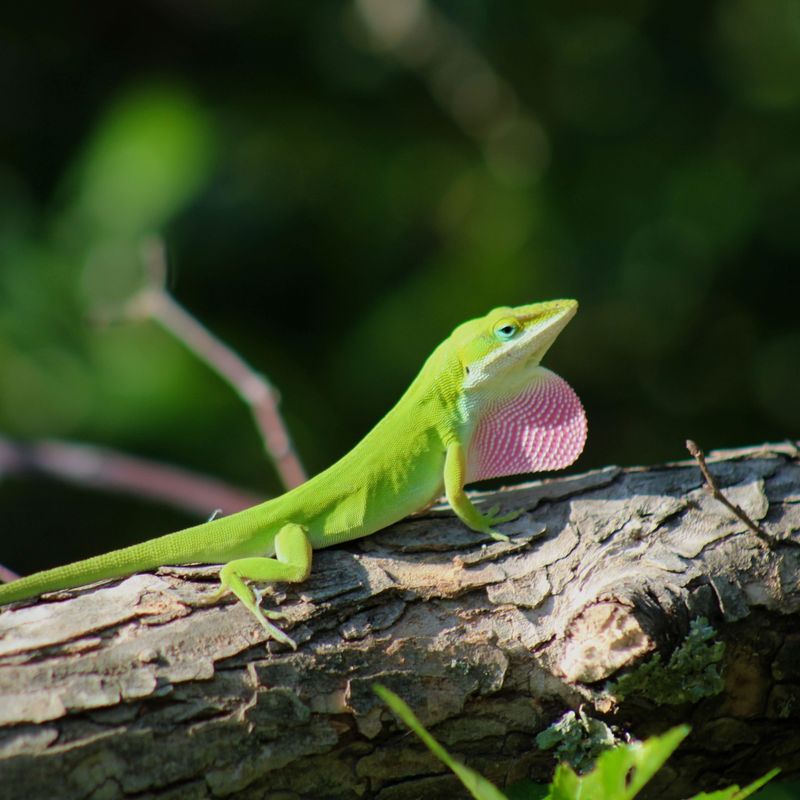
Texas’ warm and varied habitats are home to the green anole, a small but captivating lizard known for its bright green coloration and ability to change color. These lizards can grow up to 8 inches long and are often seen displaying their pink dewlaps to communicate with other anoles.
Green anoles are insectivorous, feeding primarily on insects and spiders, and they play a role in controlling pest populations. Their remarkable agility allows them to navigate trees and shrubs with ease, making them a common sight in gardens and natural areas.
While not endangered, green anoles face competition from invasive species like the brown anole. Conservation efforts focus on maintaining native habitats and monitoring invasive populations. Observing a green anole in action provides insight into the dynamic ecosystems of Texas.


